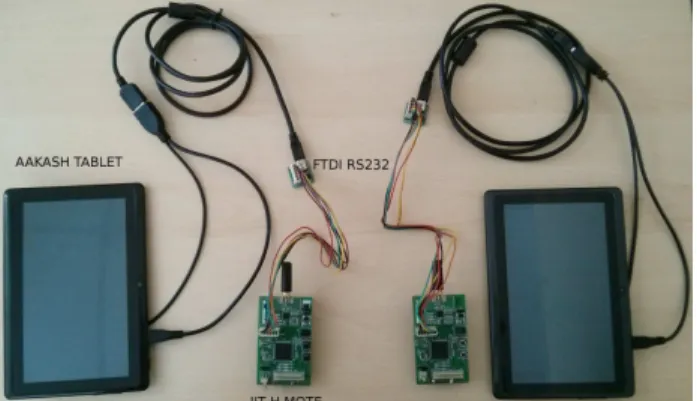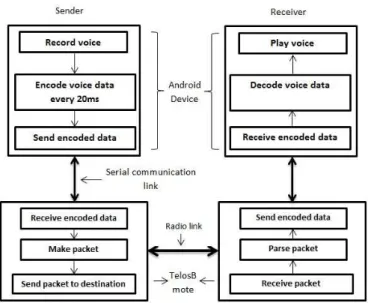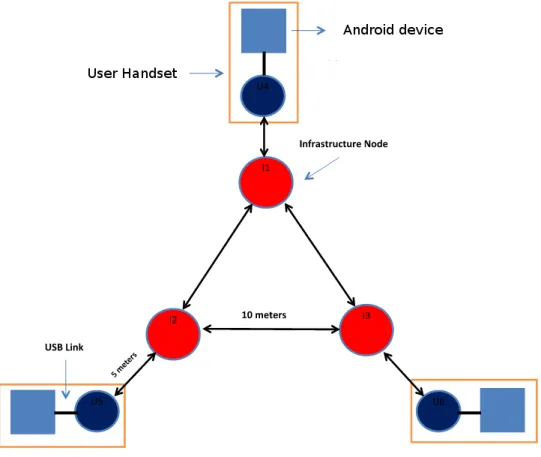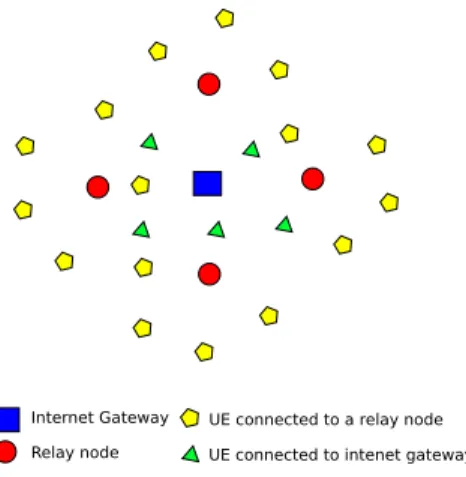Smartphone usage in India's low-income areas, which comprise over 70% of the population, is relatively low compared to urban areas. This growth is mainly driven by low-cost smartphones, which are of particular interest due to their improved capabilities and potential to enable services for the masses. In rural areas of India, majority of the population has low income and poor ability to pay mobile network operators at regular intervals.
A network of cheap and efficient power plants that can cover an entire village will be very practical in this situation because local people can communicate with each other for free. So a network of low-cost and power-efficient supporting voice communication and developed using popular and cheaply available devices like smartphones (Android devices) in the market is desirable. The advantages of this handset is that it uses Android device, which is most popular and available at affordable prices, and it uses IEEE 802.15.4/Zigbee mode, which can be connected to the Zigbee network, which is cheap and power efficient.
We have also analyzed a self-powered IEEE 802.15.4 based multi-hop network consisting of an Internet Gateway (IG) and relay nodes for providing Internet facilities in rural areas such as villages of India. In the case of proportional fair scheduling, it has already been shown in the existing literature that if the loopback capacity of both IG and relay nodes is infinite, this leads to users being given equal time in scheduling. However, in the case of the proposed multi-hop network, loopback capacity of both IG and relay nodes is limited.
WSN nodes usually consist of an 8- or 16-bit microcontroller and a short-range transmitter to create a low-cost network with the longest lifetime.
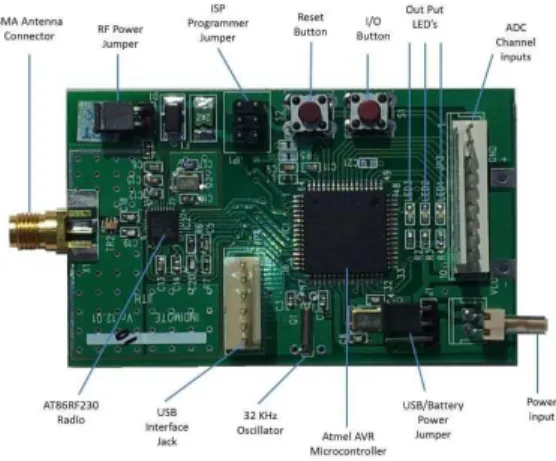
TinyOS
System model and details
Radio communication
Serial communication
In this mode, raw data sent from the tablet is converted to serial data by the RS232 FTDI chip. This application has default settings for the baud rate, data bits and parity bit to use. The RS232 chip receives the bytes, converts them to UART format and sends them byte by byte serially to the mote.
Message structure
Advantages
Conclusion
These applications require low bit rates, but the IEEE 802.15.4/Zigbee standard supports bit rates of 250 Kbit/s [9], which is much higher than what is required for the above applications. These unique properties of the IEEE 802.15.4/Zigbee standard can be exploited to enable short-range voice communication over WSNs. The main application of this can be found in underdeveloped areas that suffer from power outages and a weak economy.
The main disadvantage of the network was that proprietary handsets were used, which were expensive. As a first step towards developing a short-range communication network using commercially available devices, we implemented peer-to-peer half-duplex voice communication over IEEE 802.15.4/Zigbee using low-cost open source Android devices. Since Android devices have high-speed processors, we can implement the necessary voice codecs for efficient voice communication on them.
Additionally, the necessary hardware for voice input and output is built into the device, so no other hardware besides Zigbee motes is required for implementation.
Implementation details
- User interface layout of Android application
- Voice Recording
- Speex Voice Codec
- Serial Communication
- TinyOS program
At the receiving end, the received packets are parsed and forwarded to the Android device. The text field is for entering the target node ID assigned to each TelosB router. Voice data from the microphone is processed using the Android AudioRecord application program interface (API).
The main input parameters for this API are the recorder's sample rate, the audio encoding format, and the buffer size to store the voice data. The raw voice data requires fairly high bit rates to establish real-time voice communications. To operate at a low bit rate, the standard IEEE 802.15.4 voice data must be compressed.
Implementation of Speex codec involves encoding recorded voice data at sender side and decoding the received voice data at receiver side. These frames are read from the temporary file (created . while recording voice) and given as input to the Speex encoder, which compresses the given frame and returns 38 bytes of encoded voice data. Now the 38 bytes of encoded voice data are written to a file, which will be used later by the Serial communication part (subsection D).
Every time 38 bytes of data are received, it is stored in the receive buffer and this buffer is given as input to the decode method, which decodes the data and returns 320 bytes of voice data. The micro USB port of the Android device is connected to the USB port of TelosB mote using an OTG cable. This API can be used to manage and configure FTDI [17] devices externally connected to the Android device.
To make the communication real-time, we need to ensure that voice data is encoded and sent simultaneously. For this purpose we use a wire to read 38 bytes of encoded data from encoded file and write it to the micro USB. Since we need to send 38 bytes of encoded data and destination node ID, the packet size should be 39 bytes.
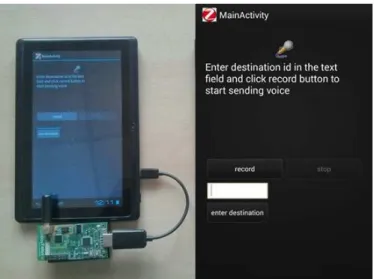
Conclusion
There are two types of nodes in Lo3: static nodes which are infrastructure nodes that act as relay nodes for data communication, and user nodes that act as initiators or terminators of data that can be mobile within the network. The infrastructure nodes are placed on the roof (height 5-10m) and a range of over 400m can be achieved for 0dBm transmit power and 8dBi omnidirectional antenna mounted at a height of less than 3m. With this arrangement, an area with a diameter of about 3 km can be covered by a network of about 20-30 infrastructure nodes.
The user handset (see 2.1) developed in this project can be used as a user node in the network described above.
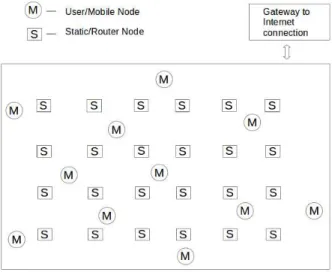
Ideal IEEE 802.15.4 network for real time voice implementation
Limiting aspects of User handset for real-time voice
But here first the encrypted data needs to go to TelosB mote, process the data, create packets and transmit using an antenna working with CSMA MAC. The developed handset cannot therefore be used directly in the LO3 network.
Non-real time voice messaging
Introduction
These two documents describe the establishment of the IEEE 802.15.4 multihop network for extending the range of the mobile network in a village and also establishing voice calls between them. They have achieved a throughput of 60 kbps which shows that even though the maximum data rate of the IEEE 802.15.4 channel is 250 kbps, transmitting data over multiple hops will reduce the network throughput. In the case of our network, the maximum number of nodes on the path is two (one hop).
Depending on the connection of users in the network, user planning is a critical task. So far, no research has been done on optimizing the time fractions to be allocated to users under IEEE 802.15.4. Assuming that different degrees of mote connections are possible, optimization can certainly be done in user planning.
[27] and [28] have implemented optimization in user scheduling and user association under infinite backhaul capacity, which is not practical in the IEEE 802.15.4 network. In one of the three cases studied, it did not provide a complete solution for optimizing user scheduling.
System Model
- Decomposition
- case 1 (µ j = 0, β j > 0)
- case 2 (µ j > 0, β j = 0)
- case 3 (µ j > 0, β j > 0)
Let us assume that the Internet gateway knows the channel capacity of the relay node a priori, and the relay nodes know the user data rates in advance. It was shown in [29] that global proportional fairness can be achieved by maximizing the following objective functionP. Rjibe the data rate of the user connected to the jth relay node and indicate the fraction of time allocated to the ith user.
The first is the problem with the Internet gateway and the other is the problem with the jth relay node. Here, the kth link's user density, the number of users served by the kth-specific link. And µ≥0,β≥0, łk ≥0 andρk ≥0 are double variables related to the Internet Gateway backhaul constraint, the time fraction constraint, the non-negativity of the time fraction constraint and the user density constraint.
If we can set the value of one of the µjorβj, the other can be obtained from 4.14. In our network case, we set a minimum lower bound on the connection speed for reasonable performance. So|Aj| ≤4.16, which means the maximum number of users that can be served by the relay node can be|Aj|max=4.
By replacing the roots obtained in all possible |Aj| in 4.15, we can obtain the corresponding user schedules αji. And the solution to the local internet gateway problem is obtained by solving the following Lagrange equation.
Conclusion
16] http://www.ftdichip.com/Support/Documents/AppNotes/AN 233 Java D2xx for Android API User Manual.pdf.
